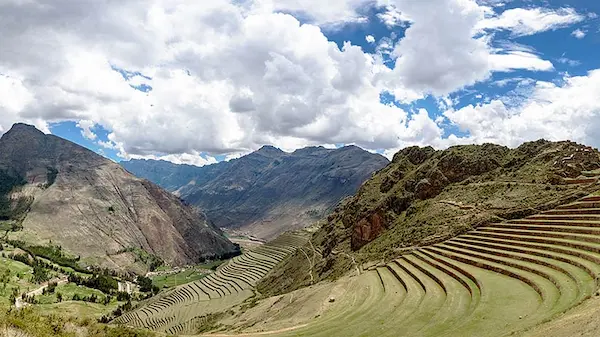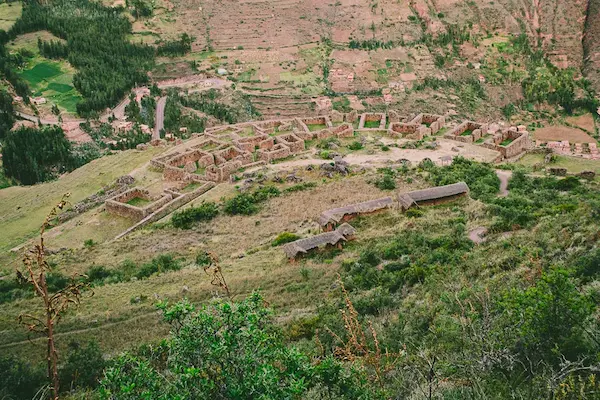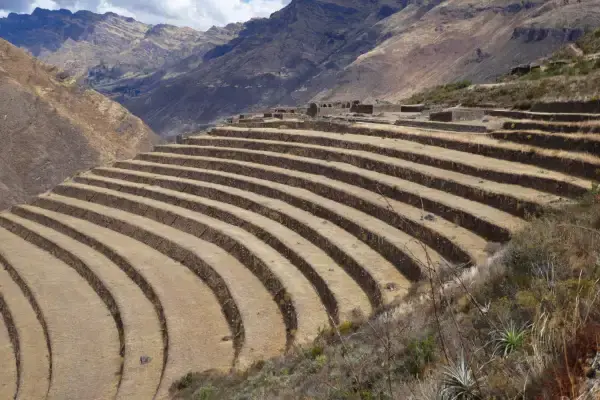Av Retamayoc L-10, San Sebastián 08002
- +51 940 809 144
- Travel Blog
- About Us
- Contact Us
Av Retamayoc L-10, San Sebastián 08002
Chat to a Andean Road Peru
Nestled in the heart of Peru’s Sacred Valley, Pisac is one of the most enchanting destinations for travelers seeking to immerse themselves in the region’s rich history, vibrant culture, and breathtaking landscapes. Located just 30 kilometers from Cusco, this charming town offers a perfect blend of ancient Inca ruins, traditional Andean craftsmanship, and stunning natural beauty. The Pisac Ruins, a remarkable archaeological site perched high above the valley, attract countless visitors eager to explore the remnants of the Inca Empire. But Pisac has much more to offer, from its lively artisan market to its deep cultural and historical significance.
Maybe you’d like to read: The History of Tambomachay: The Inca Water Temple

Reaching Pisac from Cusco is a picturesque journey that takes about 40 minutes by car. Whether you're driving or traveling by bus, the winding roads through the Andean mountains offer spectacular views of the surrounding valleys and villages. Travelers can take a public bus from the Cusco bus terminal, a cost-effective way to reach Pisac. Alternatively, taxis are readily available, or you can join a guided day tour that combines a visit to Pisac with stops at other nearby archaeological sites.
For those who prefer more flexibility, renting a car is also a great option. The road is generally well-maintained, and driving provides the opportunity to stop along the way to admire the incredible landscapes of the Sacred Valley.
No visit to Pisac is complete without exploring its famous artisan market, a vibrant, bustling hub located in the town’s main square. The market is a treasure trove of traditional Andean craftsmanship, offering a wide range of locally made goods. You’ll find alpaca wool textiles, including sweaters, scarves, and blankets, all beautifully woven with intricate patterns. Handcrafted jewelry, often featuring turquoise and other native stones, is another popular item at the market.
The Pisac ruins market is also an excellent place to purchase handmade pottery, colorful tapestries, wooden carvings, and a variety of other artisan goods. Each vendor proudly displays their work, offering a glimpse into the rich cultural heritage of the region. Bargaining is common at the market, but always approach it with respect for the craft and the artisans.
Visiting the market not only allows you to pick up unique souvenirs but also offers a window into the daily lives of the local people, many of whom still uphold the traditional ways of life passed down through generations.
Maybe you’d like to read: Puka Pukara Archaeological complex: A Glimpse into Inca Culture

The Pisac Archaeological Site is one of the most impressive remnants of Inca civilization in the Sacred Valley. Sitting atop a mountain above the town, the site offers stunning panoramic views of the surrounding landscape, including the valley below and the distant snow-capped peaks. The Pisac Ruins boast extensive agricultural terraces, religious buildings, and intricate stonework, all showcasing the advanced engineering skills of the Incas.
At the heart of the site lies the Intihuatana, also known as the "Sun Temple." The word "Intihuatana" means "hitching post of the sun," and it is a sacred Inca stone structure believed to have been used to mark the sun’s position during solstices and equinoxes. This was vital to the Inca people, as it helped them determine the appropriate times for planting and harvesting crops. The Intihuatana is one of the most iconic and awe-inspiring structures in the ruins, offering a tangible connection to the ancient civilization that once thrived in the region.
Visitors can access the Pisac ruins in two ways. A short but steep hike from the town will take you directly to the site, offering the chance to immerse yourself in the natural beauty of the valley and witness the incredible agricultural terraces up close. The hike typically takes around an hour, and as you ascend, you’ll pass through ancient tunnels carved into the mountainside.
Alternatively, you can take a taxi or tour vehicle to the entrance for a more convenient visit. Once at the top, you can explore the ceremonial platforms, temples, and plazas once used by the Incas for religious rituals and important events.
The Pisac Archaeological Site, perched atop a mountain overlooking the town, is one of the most remarkable remnants of Inca civilization in the Sacred Valley. Renowned for its agricultural terraces, religious structures, and intricate stonework, the site is a testament to the advanced engineering and agricultural knowledge of the Incas. Its strategic location offers breathtaking panoramic views of the surrounding valley and distant snow-capped peaks, adding to its allure.
A focal point of the ruins is the Intihuatana, or "Sun Temple," an iconic Inca structure believed to have been used to mark the position of the sun during solstices and equinoxes. This sacred stone was crucial for determining the best times for planting and harvesting crops, highlighting the Incas' deep connection to the natural world and their astute understanding of astronomy.
Visitors can reach the Pisac ruins either by a short but steep hike from the town or by taxi or tour vehicle. The hike, which takes about an hour, leads visitors through ancient tunnels and provides a closer look at the agricultural terraces. Alternatively, a more convenient vehicle ride will bring you directly to the entrance, where you can explore the ceremonial platforms, temples, and plazas that once played a vital role in Inca religious practices.
Maybe you’d like to read: Chinchero: A glimpse into the living inca culture

If you're up for an adventure, hiking around the Pisac ruins offers the chance to explore the vast agricultural terraces and discover hidden tombs. The hike from the town to the ruins passes through two ancient tunnels and offers panoramic views of the Sacred Valley.
The Intihuatana is the focal point of the hike. Meaning “hitching post of the sun,” this structure allowed the Incas to mark solstices and equinoxes, aligning their agricultural calendar. The site’s architectural brilliance shines through in its perfectly carved stones, which fit together seamlessly without the use of mortar.
The Pisac ruins are a must-visit destination for anyone traveling through the Sacred Valley of Peru. These awe-inspiring ruins offer a fascinating glimpse into the ancient Inca world, with their impressive terraces and intricate stone structures. In addition to the ruins, the vibrant artisan market showcases the region's rich cultural traditions, offering visitors a chance to experience local craftsmanship and shop for unique souvenirs. Whether you’re interested in history, hiking, shopping, or simply soaking in the stunning landscapes, Pisac provides a memorable and enriching experience. As you wander through its ancient terraces and explore its lively market, you'll feel a deep connection to the enduring spirit of the Andean people and the incredible legacy of the Inca Empire.
You can reach Pisac by bus, taxi, or organized tour from Cusco. The journey takes about 40 minutes by car and offers beautiful views of the Sacred Valley along the way. Public buses are available from Cusco’s bus terminal and are a budget-friendly option.
The best time to visit Pisac is during the dry season, from May to September. During these months, you’ll enjoy clear skies and pleasant weather, ideal for exploring the Pisac ruins and the town’s famous artisan market. Be prepared for sunny days and possible altitude effects.
The Pisac artisan market is known for its wide range of handmade crafts. You can find high-quality alpaca wool products such as scarves, sweaters, and blankets, as well as ceramics, jewelry, and traditional Andean textiles. Bargaining is common but always show respect for the artisans.
To fully explore Pisac, including the ruins and the market, you should set aside at least half a day. If you’re hiking up to the Pisac Archaeological Site, it’s recommended to give yourself a few hours to enjoy the scenic views and explore the ruins at a relaxed pace.
Yes, there is an entry fee to visit the Pisac ruins. International visitors need to purchase the Boleto Turístico (Tourist Ticket), which grants access to several sites in the Sacred Valley, including Pisac. Peruvian citizens, especially locals from Cusco, may enter for free or at a discounted rate.
Leave a comment